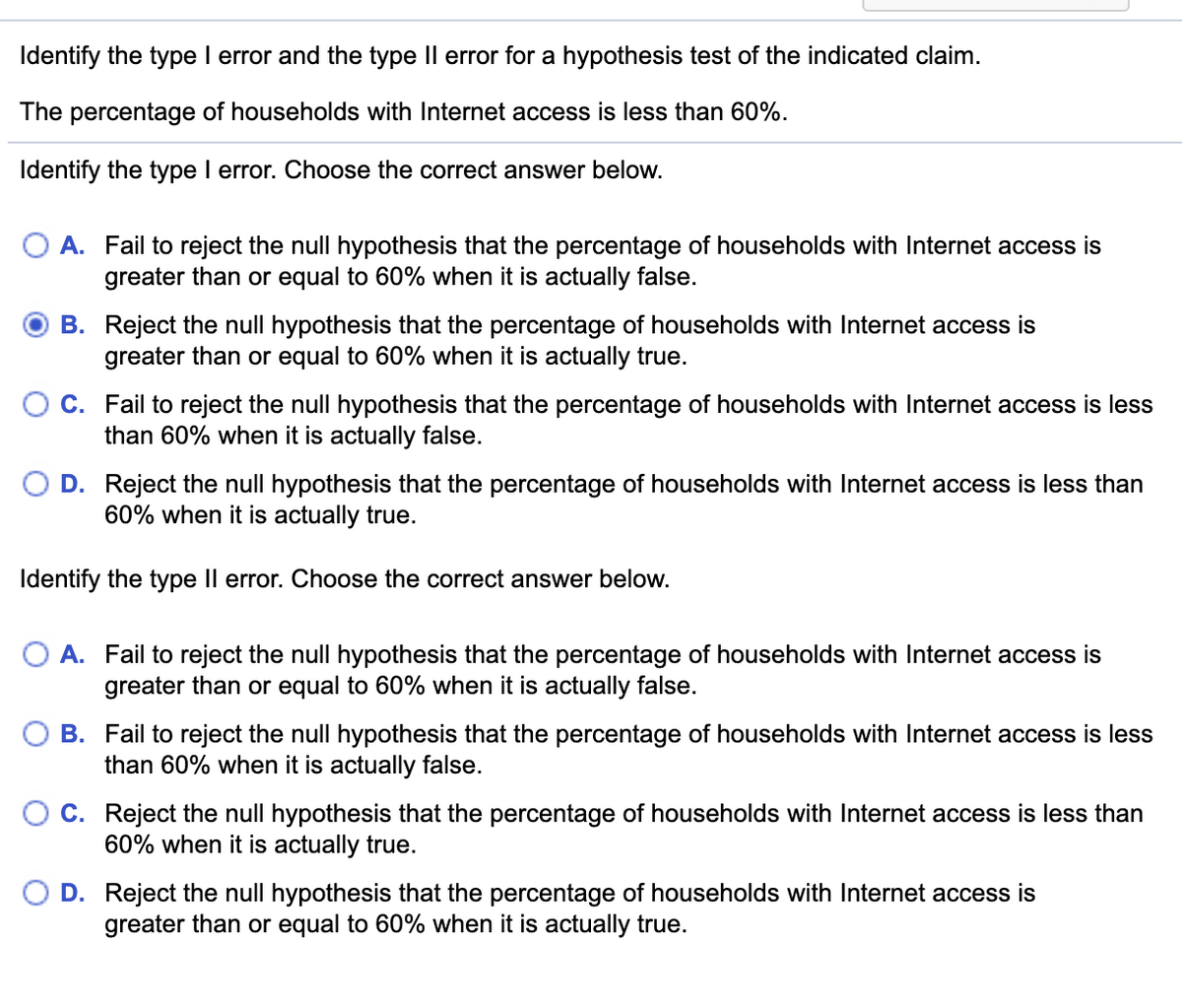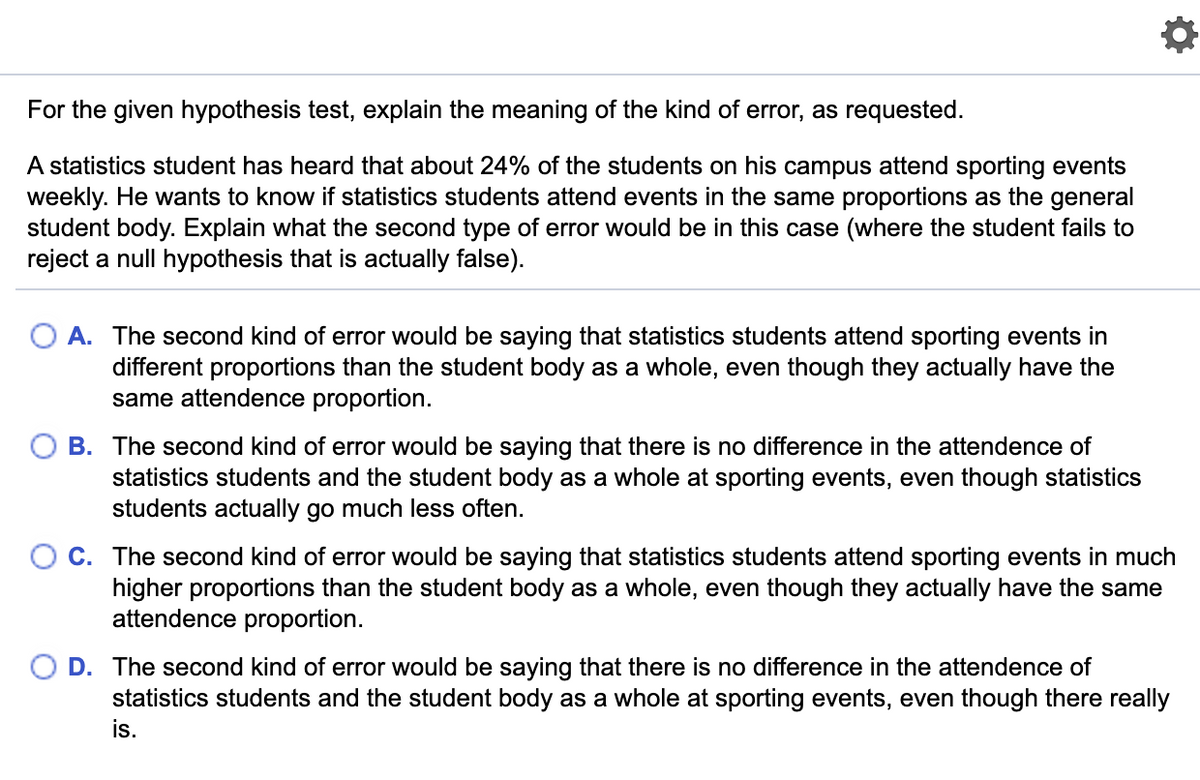Identify the type I error and the type II error for a hypothesis test of the indicated claim. The percentage of households with Internet access is less than 60%. Identify the type I error. Choose the correct answer below. O A. Fail to reject the null hypothesis that the percentage of households with Internet access is greater than or equal to 60% when it is actually false. B. Reject the null hypothesis that the percentage of households with Internet access is greater than or equal to 60% when it is actually true. C. Fail to reject the null hypothesis that the percentage of households with Internet access is less than 60% when it is actually false. D. Reject the null hypothesis that the percentage of households with Internet access is less than 60% when it is actually true. Identify the type II error. Choose the correct answer below. A. Fail to reject the null hypothesis that the percentage of households with Internet access is greater than or equal to 60% when it is actually false. B. Fail to reject the null hypothesis that the percentage of households with Internet access is less than 60% when it is actually false. C. Reject the null hypothesis that the percentage of households with Internet access is less than 60% when it is actually true. D. Reject the null hypothesis that the percentage of households with Internet access is greater than or equal to 60% when it is actually true.
Identify the type I error and the type II error for a hypothesis test of the indicated claim. The percentage of households with Internet access is less than 60%. Identify the type I error. Choose the correct answer below. O A. Fail to reject the null hypothesis that the percentage of households with Internet access is greater than or equal to 60% when it is actually false. B. Reject the null hypothesis that the percentage of households with Internet access is greater than or equal to 60% when it is actually true. C. Fail to reject the null hypothesis that the percentage of households with Internet access is less than 60% when it is actually false. D. Reject the null hypothesis that the percentage of households with Internet access is less than 60% when it is actually true. Identify the type II error. Choose the correct answer below. A. Fail to reject the null hypothesis that the percentage of households with Internet access is greater than or equal to 60% when it is actually false. B. Fail to reject the null hypothesis that the percentage of households with Internet access is less than 60% when it is actually false. C. Reject the null hypothesis that the percentage of households with Internet access is less than 60% when it is actually true. D. Reject the null hypothesis that the percentage of households with Internet access is greater than or equal to 60% when it is actually true.
MATLAB: An Introduction with Applications
6th Edition
ISBN:9781119256830
Author:Amos Gilat
Publisher:Amos Gilat
Chapter1: Starting With Matlab
Section: Chapter Questions
Problem 1P
Related questions
Question
help ASAP

Transcribed Image Text:Identify the type I error and the type Il error for a hypothesis test of the indicated claim.
The percentage of households with Internet access is less than 60%.
Identify the type I error. Choose the correct answer below.
O A. Fail to reject the null hypothesis that the percentage of households with Internet access is
greater than or equal to 60% when it is actually false.
B. Reject the null hypothesis that the percentage of households with Internet access is
greater than or equal to 60% when it is actually true.
C. Fail to reject the null hypothesis that the percentage of households with Internet access is less
than 60% when it is actually false.
D. Reject the null hypothesis that the percentage of households with Internet access is less than
60% when it is actually true.
Identify the type Il error. Choose the correct answer below.
O A. Fail to reject the null hypothesis that the percentage of households with Internet access is
greater than or equal to 60% when it is actually false.
B. Fail to reject the null hypothesis that the percentage of households with Internet access is less
than 60% when it is actually false.
O C. Reject the null hypothesis that the percentage of households with Internet access is less than
60% when it is actually true.
D. Reject the null hypothesis that the percentage of households with Internet access is
greater than or equal to 60% when it is actually true.

Transcribed Image Text:For the given hypothesis test, explain the meaning of the kind of error, as requested.
A statistics student has heard that about 24% of the students on his campus attend sporting events
weekly. He wants to know if statistics students attend events in the same proportions as the general
student body. Explain what the second type of error would be in this case (where the student fails to
reject a null hypothesis that is actually false).
A. The second kind of error would be saying that statistics students attend sporting events in
different proportions than the student body as a whole, even though they actually have the
same attendence proportion.
O B. The second kind of error would be saying that there is no difference in the attendence of
statistics students and the student body as a whole at sporting events, even though statistics
students actually go much less often.
C. The second kind of error would be saying that statistics students attend sporting events in much
higher proportions than the student body as a whole, even though they actually have the same
attendence proportion.
D. The second kind of error would be saying that there is no difference in the attendence of
statistics students and the student body as a whole at sporting events, even though there really
is.
Expert Solution
This question has been solved!
Explore an expertly crafted, step-by-step solution for a thorough understanding of key concepts.
This is a popular solution!
Trending now
This is a popular solution!
Step by step
Solved in 2 steps with 3 images

Knowledge Booster
Learn more about
Need a deep-dive on the concept behind this application? Look no further. Learn more about this topic, statistics and related others by exploring similar questions and additional content below.Recommended textbooks for you

MATLAB: An Introduction with Applications
Statistics
ISBN:
9781119256830
Author:
Amos Gilat
Publisher:
John Wiley & Sons Inc

Probability and Statistics for Engineering and th…
Statistics
ISBN:
9781305251809
Author:
Jay L. Devore
Publisher:
Cengage Learning

Statistics for The Behavioral Sciences (MindTap C…
Statistics
ISBN:
9781305504912
Author:
Frederick J Gravetter, Larry B. Wallnau
Publisher:
Cengage Learning

MATLAB: An Introduction with Applications
Statistics
ISBN:
9781119256830
Author:
Amos Gilat
Publisher:
John Wiley & Sons Inc

Probability and Statistics for Engineering and th…
Statistics
ISBN:
9781305251809
Author:
Jay L. Devore
Publisher:
Cengage Learning

Statistics for The Behavioral Sciences (MindTap C…
Statistics
ISBN:
9781305504912
Author:
Frederick J Gravetter, Larry B. Wallnau
Publisher:
Cengage Learning

Elementary Statistics: Picturing the World (7th E…
Statistics
ISBN:
9780134683416
Author:
Ron Larson, Betsy Farber
Publisher:
PEARSON

The Basic Practice of Statistics
Statistics
ISBN:
9781319042578
Author:
David S. Moore, William I. Notz, Michael A. Fligner
Publisher:
W. H. Freeman

Introduction to the Practice of Statistics
Statistics
ISBN:
9781319013387
Author:
David S. Moore, George P. McCabe, Bruce A. Craig
Publisher:
W. H. Freeman